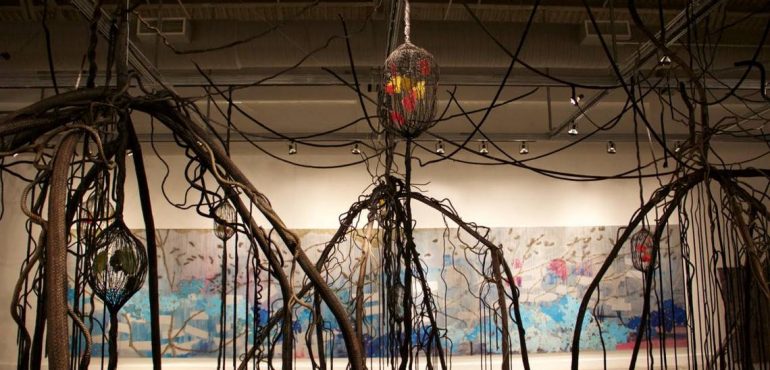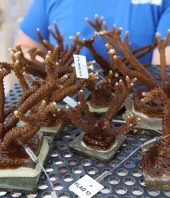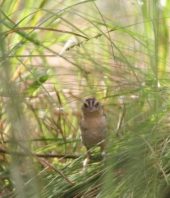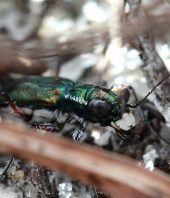Mira Lehr’s Tracing the Red Thread is arguably one of the most beautiful cries for help.
The exhibition, at The Museum of Contemporary Art North Miami, is a call to arms. “We’re in trouble,” says the Miami artist. “Environmentally, we’re in trouble.”
A disciple of futurist Buckminster Fuller, Lehr has long held that mankind can — and must — work together to resolve the Earth’s environmental problems. As a resident of Miami Beach, Lehr focuses on the failing aquatic ecosystems of South Florida, particularly dying coral reefs and destroyed mangroves. She also highlights the importance of preserving jellyfish, which may hold the secret to eternal life.
Her show is one of hope rather than dread, designed to capture the glory of what we have now — and what could be lost if we are not vigilant.
In a reference to the ancient Greek myth of Ariadne, Lehr took over the interior of the museum with a monumental labyrinth of sorts that she created from ropes and crafted into the shapes of eight floor-to-ceiling mangroves. Just as Ariadne provided a ball of red thread for Theseus to trace his steps through the maze to locate (and kill) the monstrous Minotaur, Lehr weaves a path through the mangroves with her own red rope strategically placed on the museum floor.
“The whole thing is really a search for solutions,” she says. She slyly omits who or what her Minotaur represents, eschewing the temptation to place Man in the role of Minotaur. “It could be,” she admits. “I don’t really point it out. I just point out that you could go walk through the labyrinth, the idea of a puzzle, and to find your way through to solutions.”
The concept of mangroves evolved from a site-specific installation Lehr created for an ethereal performance at Coconut Grove’s Vizcaya gardens two years ago.
The MOCA mangroves are made of hemp that’s been dyed wenge brown and looks remarkably realistic. To give it form, Lehr inserted steel rods into the rope. Throughout the mangroves, she interspersed nets filled with colorful resin pieces that represent tropical flowers.
“This adds a little bit of lightness to it,” she says. “Otherwise, it’s kind of ominous and scary.” She recognizes that not everyone will see the beauty in the starkness of the dark mangroves, and that color eases apprehension. “It’s very calming, isn’t it?” she muses while pausing to take in the expanse of it. “It’s quiet. I don’t like shows that scream at you.”
And yet this part of her show is no small gesture. Each mangrove measures some 14 feet in height and spreads out at the bottom like a giant hoop skirt. The “mangroves” are so big, they had to be constructed in two parts, a top and a bottom. The space they take up is daunting, even to the artist.
“It was hard to have [this] at my house and to get it out,” she says. “You know how we got them out? I said, ‘I hope this is not an omen’ — in garbage trucks. I said, if they go to the dump, well….”
Lehr offsets the massive size of the mangroves with four large paintings on one wall and a 40-foot-long painting on the opposite. She echoes the mangrove swamp in her paintings, comprised of silver emulsion, Japanese paper and gunpowder and fuses. In the process of creation, Lehr placed the paintings flat on the ground and ignited gunpowder and the fuses to create a scorched look. The burned area leaves a crunchy, crustaceous appearance. “You can see where the gunpowder has all these wonderful effects,” she says. “I could never get that with paint.”
In addition to mangroves, Lehr’s show includes a stylized jellyfish she made from clear resin dyed a clear blue, the color of a Bahamian bay. Beaded chains have been embedded in the resin of the chandelier-like hanging sculpture, to give the appearance of tentacles.
Lehr likes to think of jellyfish as the femmes fatales of the sea. “They’re so beautiful, but the underside of beauty can be dangerous, so you have to beware,” she says. Some tentacles contain telomeres, a compound structure at the end of a chromosome that many believe are the secret to eternal life. “If you can keep the jellyfish alive, those cells will keep dividing and dividing and dividing, eternally. Some jellyfish have them and they’re studying them for longevity in human beings.”
Just outside the small entrance room that houses the jellyfish, Lehr created a wall installation using wire mesh fashioned into the shape of individual coral. Lit from beneath by tiny lights, the coral community also displays the scientific names for various fishes and corals that are either extinct or under threat. Lehr says her friend and fellow artist, Beatriz Monteavaro, assisted by writing the names on Japanese paper “because her handwriting is better than mine.”
Coral reefs are comprised of individual units, sort of like apartments stacked atop one another, Lehr says. “If one part gets sick, the whole thing will die,” she says. While that may appear dire, all is not lost. Her exhibition ends on a hopeful note, in a room at the far end of the museum. It’s ceiling is covered in hanging lightbulbs — the kind used to breed coral in captivity.
“The good news... is that they have developed the technique of growing corals indoors,” she says. “So, it helps replenish them. And there are some corals that have adapted to the bad stuff. I think in Biscayne Bay there is a colony of corals that are tough as hell.”
Source: Full Article, Miami Herald






